Australian Trade Policy: Advantages and Disadvantages
VerifiedAdded on 2023/06/07
|14
|3435
|232
AI Summary
This report analyzes the trade policies of Australia, including its free trade agreements, import controls, tariffs and duties, and their impact on the economy, employment, and industries. It discusses the advantages and disadvantages of trade protectionism and the potential benefits and drawbacks of the free trade agreement with China.
Contribute Materials
Your contribution can guide someone’s learning journey. Share your
documents today.

Running head: ECONOMICS
Economics
Name of the student
Name od the university
Author note
Economics
Name of the student
Name od the university
Author note
Secure Best Marks with AI Grader
Need help grading? Try our AI Grader for instant feedback on your assignments.
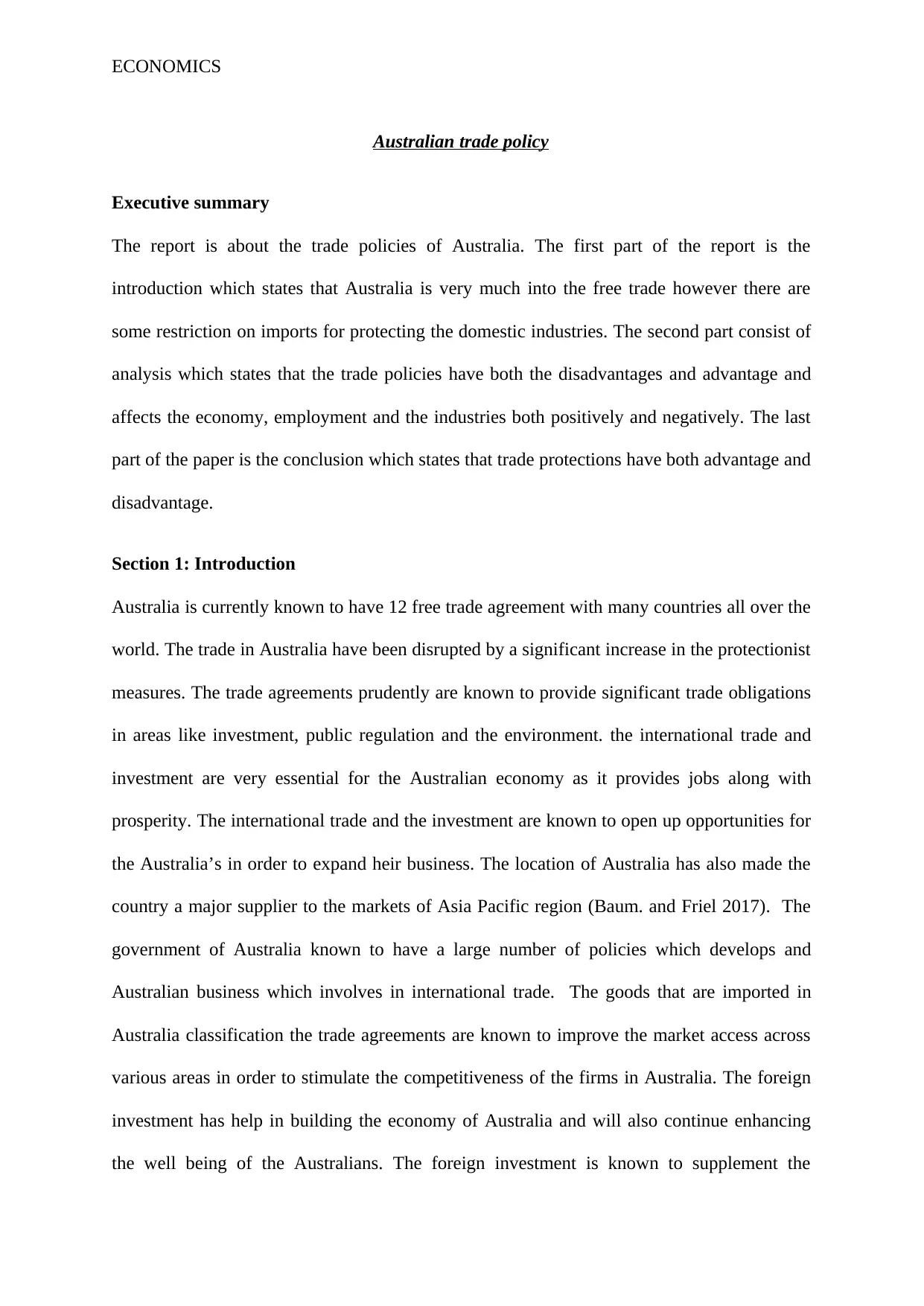
ECONOMICS
Australian trade policy
Executive summary
The report is about the trade policies of Australia. The first part of the report is the
introduction which states that Australia is very much into the free trade however there are
some restriction on imports for protecting the domestic industries. The second part consist of
analysis which states that the trade policies have both the disadvantages and advantage and
affects the economy, employment and the industries both positively and negatively. The last
part of the paper is the conclusion which states that trade protections have both advantage and
disadvantage.
Section 1: Introduction
Australia is currently known to have 12 free trade agreement with many countries all over the
world. The trade in Australia have been disrupted by a significant increase in the protectionist
measures. The trade agreements prudently are known to provide significant trade obligations
in areas like investment, public regulation and the environment. the international trade and
investment are very essential for the Australian economy as it provides jobs along with
prosperity. The international trade and the investment are known to open up opportunities for
the Australia’s in order to expand heir business. The location of Australia has also made the
country a major supplier to the markets of Asia Pacific region (Baum. and Friel 2017). The
government of Australia known to have a large number of policies which develops and
Australian business which involves in international trade. The goods that are imported in
Australia classification the trade agreements are known to improve the market access across
various areas in order to stimulate the competitiveness of the firms in Australia. The foreign
investment has help in building the economy of Australia and will also continue enhancing
the well being of the Australians. The foreign investment is known to supplement the
Australian trade policy
Executive summary
The report is about the trade policies of Australia. The first part of the report is the
introduction which states that Australia is very much into the free trade however there are
some restriction on imports for protecting the domestic industries. The second part consist of
analysis which states that the trade policies have both the disadvantages and advantage and
affects the economy, employment and the industries both positively and negatively. The last
part of the paper is the conclusion which states that trade protections have both advantage and
disadvantage.
Section 1: Introduction
Australia is currently known to have 12 free trade agreement with many countries all over the
world. The trade in Australia have been disrupted by a significant increase in the protectionist
measures. The trade agreements prudently are known to provide significant trade obligations
in areas like investment, public regulation and the environment. the international trade and
investment are very essential for the Australian economy as it provides jobs along with
prosperity. The international trade and the investment are known to open up opportunities for
the Australia’s in order to expand heir business. The location of Australia has also made the
country a major supplier to the markets of Asia Pacific region (Baum. and Friel 2017). The
government of Australia known to have a large number of policies which develops and
Australian business which involves in international trade. The goods that are imported in
Australia classification the trade agreements are known to improve the market access across
various areas in order to stimulate the competitiveness of the firms in Australia. The foreign
investment has help in building the economy of Australia and will also continue enhancing
the well being of the Australians. The foreign investment is known to supplement the
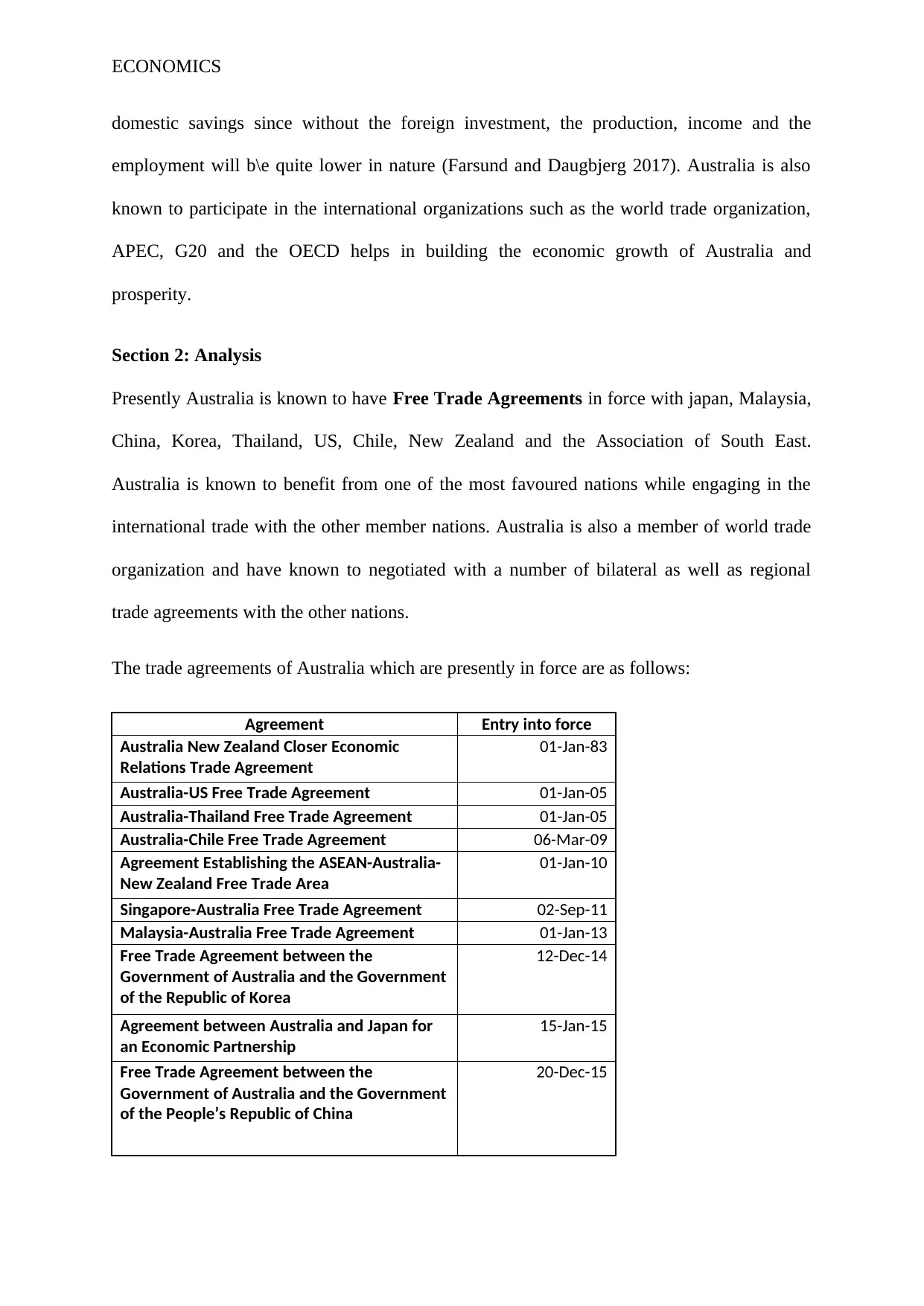
ECONOMICS
domestic savings since without the foreign investment, the production, income and the
employment will b\e quite lower in nature (Farsund and Daugbjerg 2017). Australia is also
known to participate in the international organizations such as the world trade organization,
APEC, G20 and the OECD helps in building the economic growth of Australia and
prosperity.
Section 2: Analysis
Presently Australia is known to have Free Trade Agreements in force with japan, Malaysia,
China, Korea, Thailand, US, Chile, New Zealand and the Association of South East.
Australia is known to benefit from one of the most favoured nations while engaging in the
international trade with the other member nations. Australia is also a member of world trade
organization and have known to negotiated with a number of bilateral as well as regional
trade agreements with the other nations.
The trade agreements of Australia which are presently in force are as follows:
Agreement Entry into force
Australia New Zealand Closer Economic
Relations Trade Agreement
01-Jan-83
Australia-US Free Trade Agreement 01-Jan-05
Australia-Thailand Free Trade Agreement 01-Jan-05
Australia-Chile Free Trade Agreement 06-Mar-09
Agreement Establishing the ASEAN-Australia-
New Zealand Free Trade Area
01-Jan-10
Singapore-Australia Free Trade Agreement 02-Sep-11
Malaysia-Australia Free Trade Agreement 01-Jan-13
Free Trade Agreement between the
Government of Australia and the Government
of the Republic of Korea
12-Dec-14
Agreement between Australia and Japan for
an Economic Partnership
15-Jan-15
Free Trade Agreement between the
Government of Australia and the Government
of the People’s Republic of China
20-Dec-15
domestic savings since without the foreign investment, the production, income and the
employment will b\e quite lower in nature (Farsund and Daugbjerg 2017). Australia is also
known to participate in the international organizations such as the world trade organization,
APEC, G20 and the OECD helps in building the economic growth of Australia and
prosperity.
Section 2: Analysis
Presently Australia is known to have Free Trade Agreements in force with japan, Malaysia,
China, Korea, Thailand, US, Chile, New Zealand and the Association of South East.
Australia is known to benefit from one of the most favoured nations while engaging in the
international trade with the other member nations. Australia is also a member of world trade
organization and have known to negotiated with a number of bilateral as well as regional
trade agreements with the other nations.
The trade agreements of Australia which are presently in force are as follows:
Agreement Entry into force
Australia New Zealand Closer Economic
Relations Trade Agreement
01-Jan-83
Australia-US Free Trade Agreement 01-Jan-05
Australia-Thailand Free Trade Agreement 01-Jan-05
Australia-Chile Free Trade Agreement 06-Mar-09
Agreement Establishing the ASEAN-Australia-
New Zealand Free Trade Area
01-Jan-10
Singapore-Australia Free Trade Agreement 02-Sep-11
Malaysia-Australia Free Trade Agreement 01-Jan-13
Free Trade Agreement between the
Government of Australia and the Government
of the Republic of Korea
12-Dec-14
Agreement between Australia and Japan for
an Economic Partnership
15-Jan-15
Free Trade Agreement between the
Government of Australia and the Government
of the People’s Republic of China
20-Dec-15
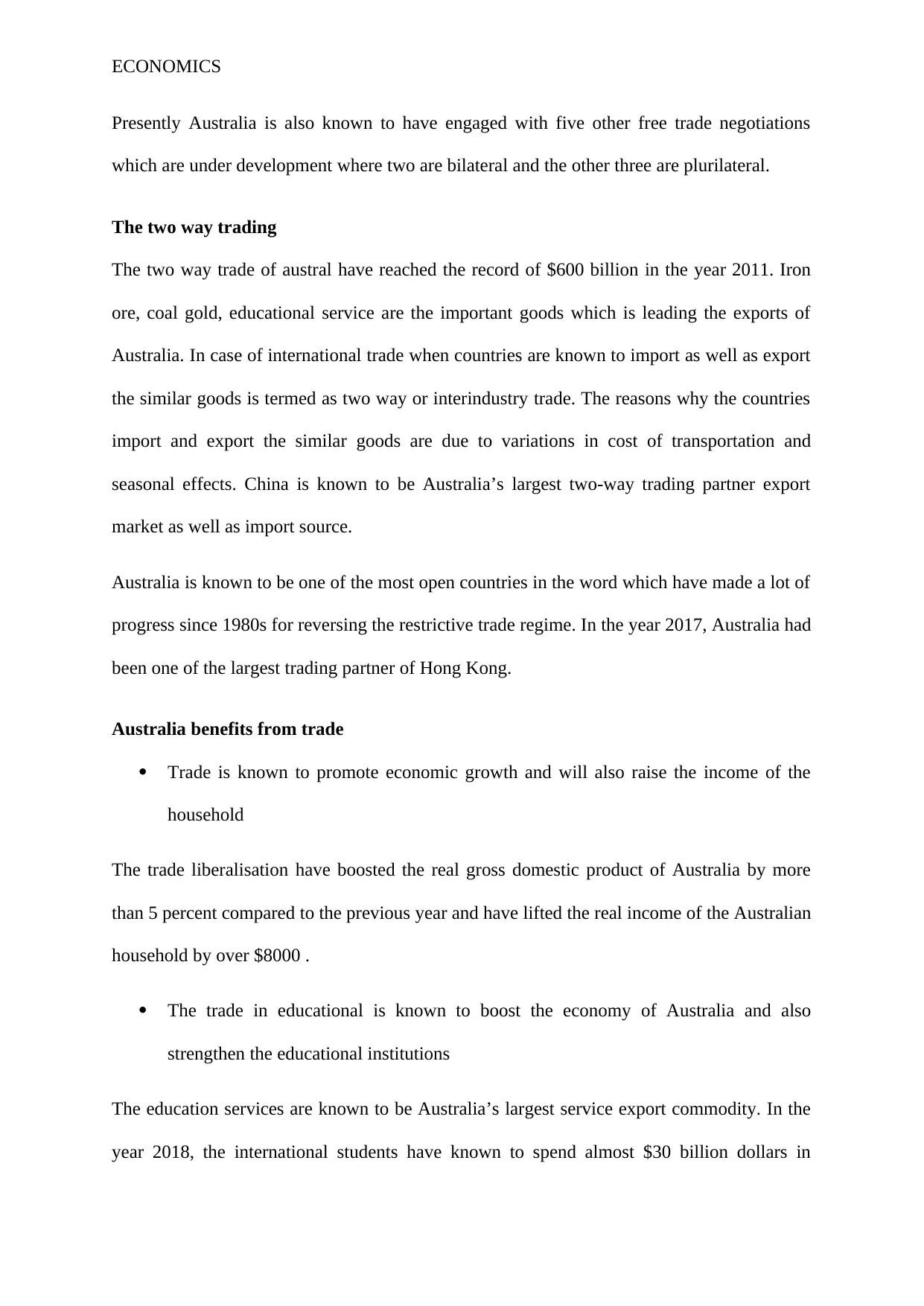
ECONOMICS
Presently Australia is also known to have engaged with five other free trade negotiations
which are under development where two are bilateral and the other three are plurilateral.
The two way trading
The two way trade of austral have reached the record of $600 billion in the year 2011. Iron
ore, coal gold, educational service are the important goods which is leading the exports of
Australia. In case of international trade when countries are known to import as well as export
the similar goods is termed as two way or interindustry trade. The reasons why the countries
import and export the similar goods are due to variations in cost of transportation and
seasonal effects. China is known to be Australia’s largest two-way trading partner export
market as well as import source.
Australia is known to be one of the most open countries in the word which have made a lot of
progress since 1980s for reversing the restrictive trade regime. In the year 2017, Australia had
been one of the largest trading partner of Hong Kong.
Australia benefits from trade
Trade is known to promote economic growth and will also raise the income of the
household
The trade liberalisation have boosted the real gross domestic product of Australia by more
than 5 percent compared to the previous year and have lifted the real income of the Australian
household by over $8000 .
The trade in educational is known to boost the economy of Australia and also
strengthen the educational institutions
The education services are known to be Australia’s largest service export commodity. In the
year 2018, the international students have known to spend almost $30 billion dollars in
Presently Australia is also known to have engaged with five other free trade negotiations
which are under development where two are bilateral and the other three are plurilateral.
The two way trading
The two way trade of austral have reached the record of $600 billion in the year 2011. Iron
ore, coal gold, educational service are the important goods which is leading the exports of
Australia. In case of international trade when countries are known to import as well as export
the similar goods is termed as two way or interindustry trade. The reasons why the countries
import and export the similar goods are due to variations in cost of transportation and
seasonal effects. China is known to be Australia’s largest two-way trading partner export
market as well as import source.
Australia is known to be one of the most open countries in the word which have made a lot of
progress since 1980s for reversing the restrictive trade regime. In the year 2017, Australia had
been one of the largest trading partner of Hong Kong.
Australia benefits from trade
Trade is known to promote economic growth and will also raise the income of the
household
The trade liberalisation have boosted the real gross domestic product of Australia by more
than 5 percent compared to the previous year and have lifted the real income of the Australian
household by over $8000 .
The trade in educational is known to boost the economy of Australia and also
strengthen the educational institutions
The education services are known to be Australia’s largest service export commodity. In the
year 2018, the international students have known to spend almost $30 billion dollars in
Secure Best Marks with AI Grader
Need help grading? Try our AI Grader for instant feedback on your assignments.
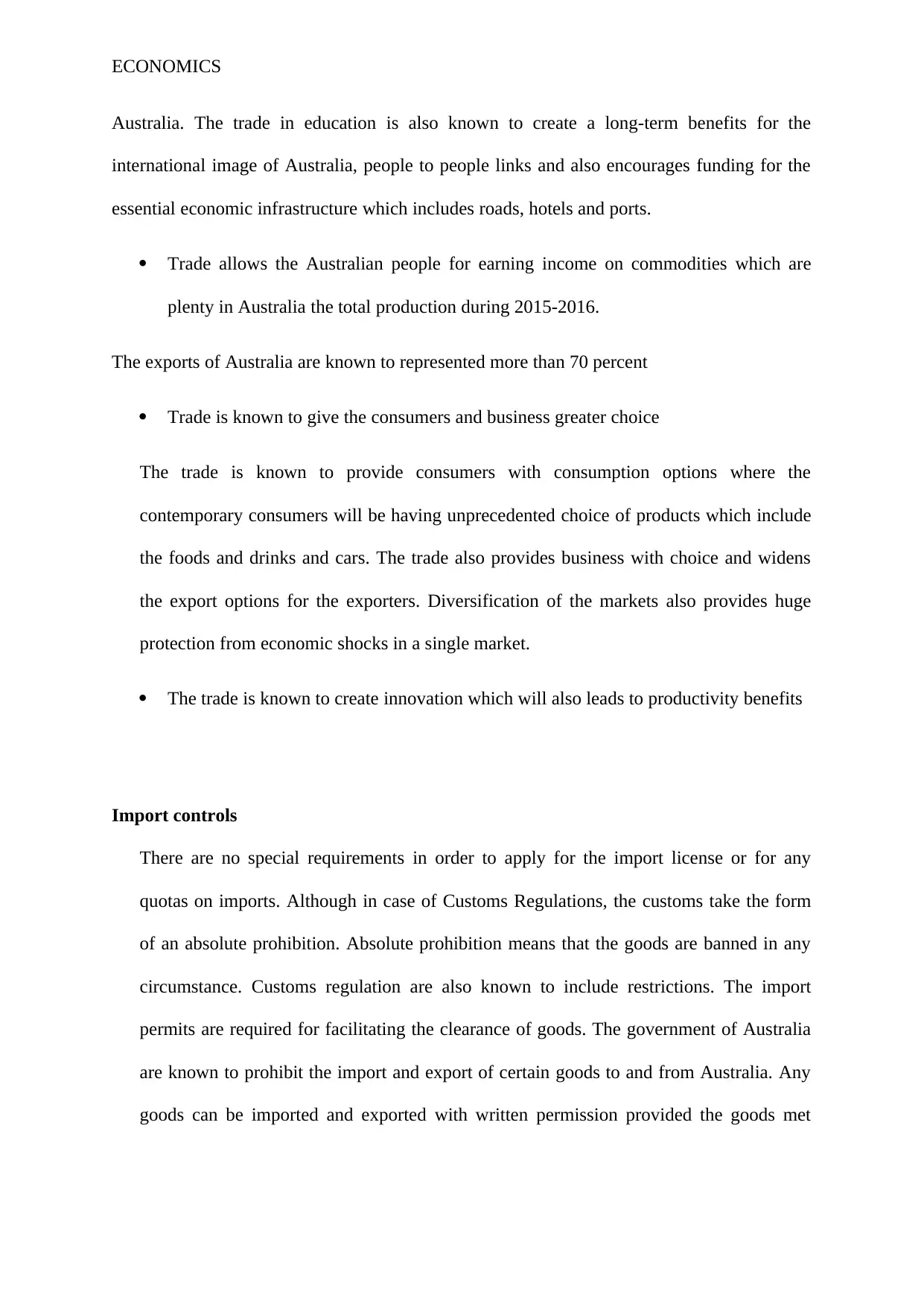
ECONOMICS
Australia. The trade in education is also known to create a long-term benefits for the
international image of Australia, people to people links and also encourages funding for the
essential economic infrastructure which includes roads, hotels and ports.
Trade allows the Australian people for earning income on commodities which are
plenty in Australia the total production during 2015-2016.
The exports of Australia are known to represented more than 70 percent
Trade is known to give the consumers and business greater choice
The trade is known to provide consumers with consumption options where the
contemporary consumers will be having unprecedented choice of products which include
the foods and drinks and cars. The trade also provides business with choice and widens
the export options for the exporters. Diversification of the markets also provides huge
protection from economic shocks in a single market.
The trade is known to create innovation which will also leads to productivity benefits
Import controls
There are no special requirements in order to apply for the import license or for any
quotas on imports. Although in case of Customs Regulations, the customs take the form
of an absolute prohibition. Absolute prohibition means that the goods are banned in any
circumstance. Customs regulation are also known to include restrictions. The import
permits are required for facilitating the clearance of goods. The government of Australia
are known to prohibit the import and export of certain goods to and from Australia. Any
goods can be imported and exported with written permission provided the goods met
Australia. The trade in education is also known to create a long-term benefits for the
international image of Australia, people to people links and also encourages funding for the
essential economic infrastructure which includes roads, hotels and ports.
Trade allows the Australian people for earning income on commodities which are
plenty in Australia the total production during 2015-2016.
The exports of Australia are known to represented more than 70 percent
Trade is known to give the consumers and business greater choice
The trade is known to provide consumers with consumption options where the
contemporary consumers will be having unprecedented choice of products which include
the foods and drinks and cars. The trade also provides business with choice and widens
the export options for the exporters. Diversification of the markets also provides huge
protection from economic shocks in a single market.
The trade is known to create innovation which will also leads to productivity benefits
Import controls
There are no special requirements in order to apply for the import license or for any
quotas on imports. Although in case of Customs Regulations, the customs take the form
of an absolute prohibition. Absolute prohibition means that the goods are banned in any
circumstance. Customs regulation are also known to include restrictions. The import
permits are required for facilitating the clearance of goods. The government of Australia
are known to prohibit the import and export of certain goods to and from Australia. Any
goods can be imported and exported with written permission provided the goods met
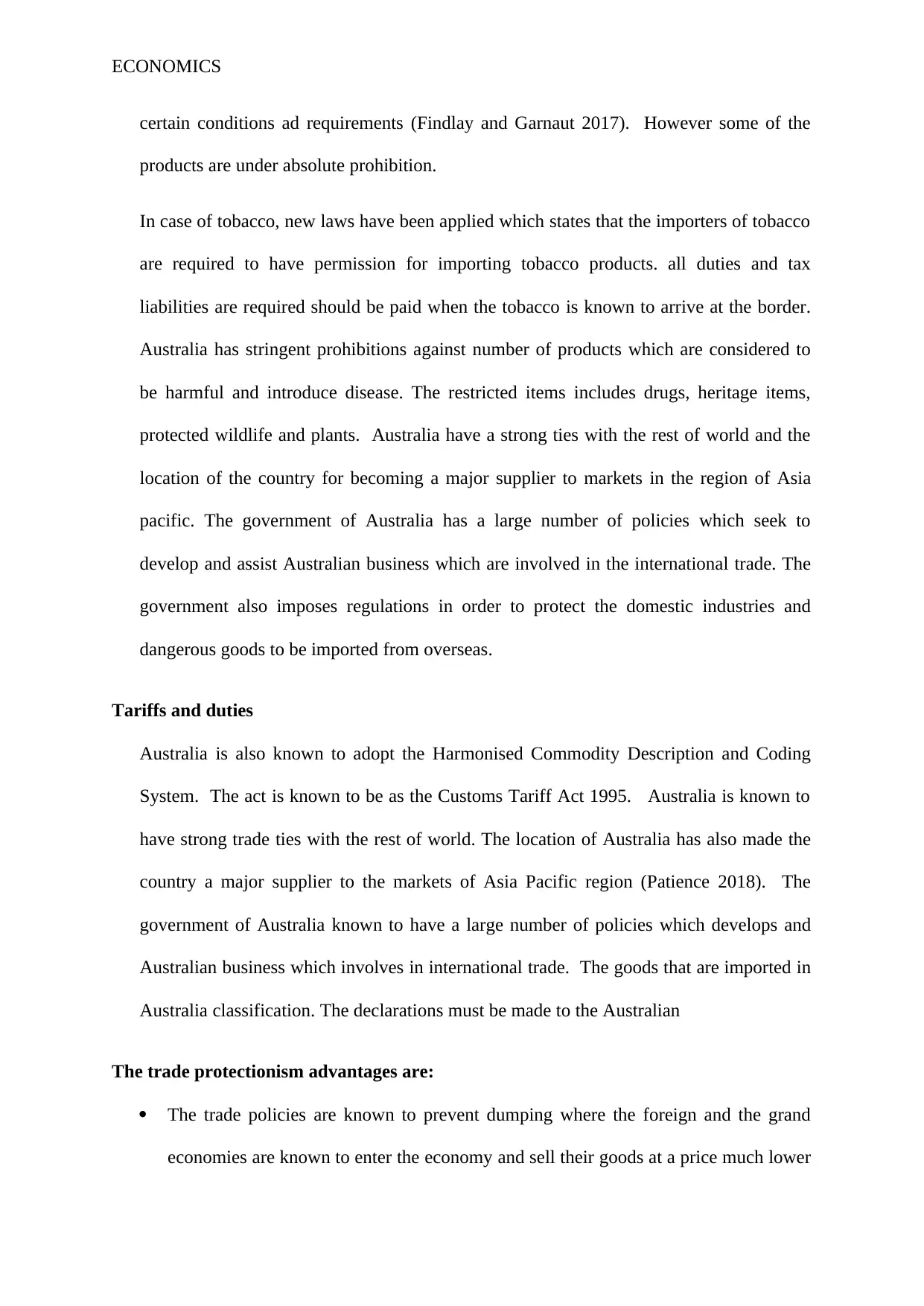
ECONOMICS
certain conditions ad requirements (Findlay and Garnaut 2017). However some of the
products are under absolute prohibition.
In case of tobacco, new laws have been applied which states that the importers of tobacco
are required to have permission for importing tobacco products. all duties and tax
liabilities are required should be paid when the tobacco is known to arrive at the border.
Australia has stringent prohibitions against number of products which are considered to
be harmful and introduce disease. The restricted items includes drugs, heritage items,
protected wildlife and plants. Australia have a strong ties with the rest of world and the
location of the country for becoming a major supplier to markets in the region of Asia
pacific. The government of Australia has a large number of policies which seek to
develop and assist Australian business which are involved in the international trade. The
government also imposes regulations in order to protect the domestic industries and
dangerous goods to be imported from overseas.
Tariffs and duties
Australia is also known to adopt the Harmonised Commodity Description and Coding
System. The act is known to be as the Customs Tariff Act 1995. Australia is known to
have strong trade ties with the rest of world. The location of Australia has also made the
country a major supplier to the markets of Asia Pacific region (Patience 2018). The
government of Australia known to have a large number of policies which develops and
Australian business which involves in international trade. The goods that are imported in
Australia classification. The declarations must be made to the Australian
The trade protectionism advantages are:
The trade policies are known to prevent dumping where the foreign and the grand
economies are known to enter the economy and sell their goods at a price much lower
certain conditions ad requirements (Findlay and Garnaut 2017). However some of the
products are under absolute prohibition.
In case of tobacco, new laws have been applied which states that the importers of tobacco
are required to have permission for importing tobacco products. all duties and tax
liabilities are required should be paid when the tobacco is known to arrive at the border.
Australia has stringent prohibitions against number of products which are considered to
be harmful and introduce disease. The restricted items includes drugs, heritage items,
protected wildlife and plants. Australia have a strong ties with the rest of world and the
location of the country for becoming a major supplier to markets in the region of Asia
pacific. The government of Australia has a large number of policies which seek to
develop and assist Australian business which are involved in the international trade. The
government also imposes regulations in order to protect the domestic industries and
dangerous goods to be imported from overseas.
Tariffs and duties
Australia is also known to adopt the Harmonised Commodity Description and Coding
System. The act is known to be as the Customs Tariff Act 1995. Australia is known to
have strong trade ties with the rest of world. The location of Australia has also made the
country a major supplier to the markets of Asia Pacific region (Patience 2018). The
government of Australia known to have a large number of policies which develops and
Australian business which involves in international trade. The goods that are imported in
Australia classification. The declarations must be made to the Australian
The trade protectionism advantages are:
The trade policies are known to prevent dumping where the foreign and the grand
economies are known to enter the economy and sell their goods at a price much lower
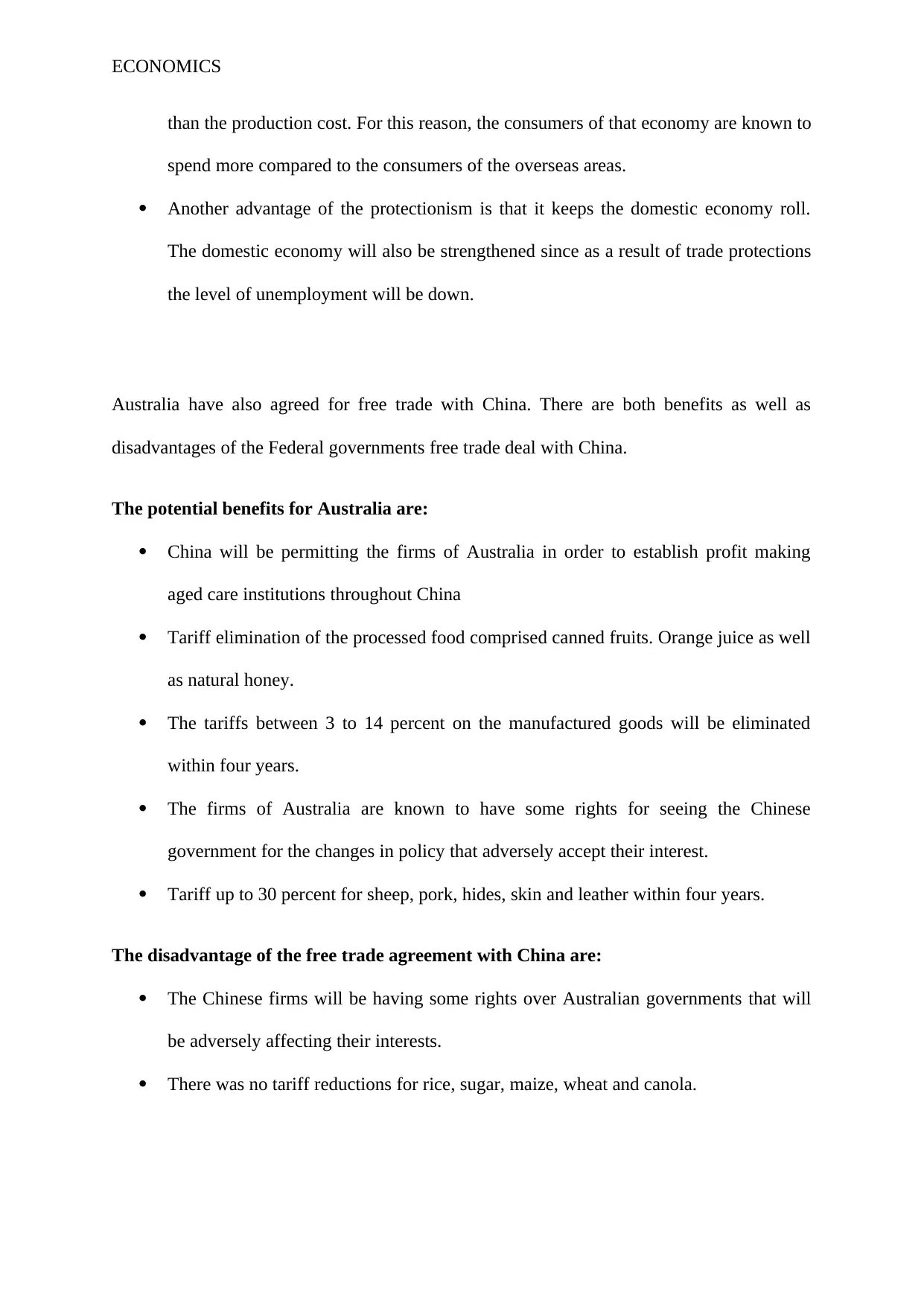
ECONOMICS
than the production cost. For this reason, the consumers of that economy are known to
spend more compared to the consumers of the overseas areas.
Another advantage of the protectionism is that it keeps the domestic economy roll.
The domestic economy will also be strengthened since as a result of trade protections
the level of unemployment will be down.
Australia have also agreed for free trade with China. There are both benefits as well as
disadvantages of the Federal governments free trade deal with China.
The potential benefits for Australia are:
China will be permitting the firms of Australia in order to establish profit making
aged care institutions throughout China
Tariff elimination of the processed food comprised canned fruits. Orange juice as well
as natural honey.
The tariffs between 3 to 14 percent on the manufactured goods will be eliminated
within four years.
The firms of Australia are known to have some rights for seeing the Chinese
government for the changes in policy that adversely accept their interest.
Tariff up to 30 percent for sheep, pork, hides, skin and leather within four years.
The disadvantage of the free trade agreement with China are:
The Chinese firms will be having some rights over Australian governments that will
be adversely affecting their interests.
There was no tariff reductions for rice, sugar, maize, wheat and canola.
than the production cost. For this reason, the consumers of that economy are known to
spend more compared to the consumers of the overseas areas.
Another advantage of the protectionism is that it keeps the domestic economy roll.
The domestic economy will also be strengthened since as a result of trade protections
the level of unemployment will be down.
Australia have also agreed for free trade with China. There are both benefits as well as
disadvantages of the Federal governments free trade deal with China.
The potential benefits for Australia are:
China will be permitting the firms of Australia in order to establish profit making
aged care institutions throughout China
Tariff elimination of the processed food comprised canned fruits. Orange juice as well
as natural honey.
The tariffs between 3 to 14 percent on the manufactured goods will be eliminated
within four years.
The firms of Australia are known to have some rights for seeing the Chinese
government for the changes in policy that adversely accept their interest.
Tariff up to 30 percent for sheep, pork, hides, skin and leather within four years.
The disadvantage of the free trade agreement with China are:
The Chinese firms will be having some rights over Australian governments that will
be adversely affecting their interests.
There was no tariff reductions for rice, sugar, maize, wheat and canola.
Paraphrase This Document
Need a fresh take? Get an instant paraphrase of this document with our AI Paraphraser
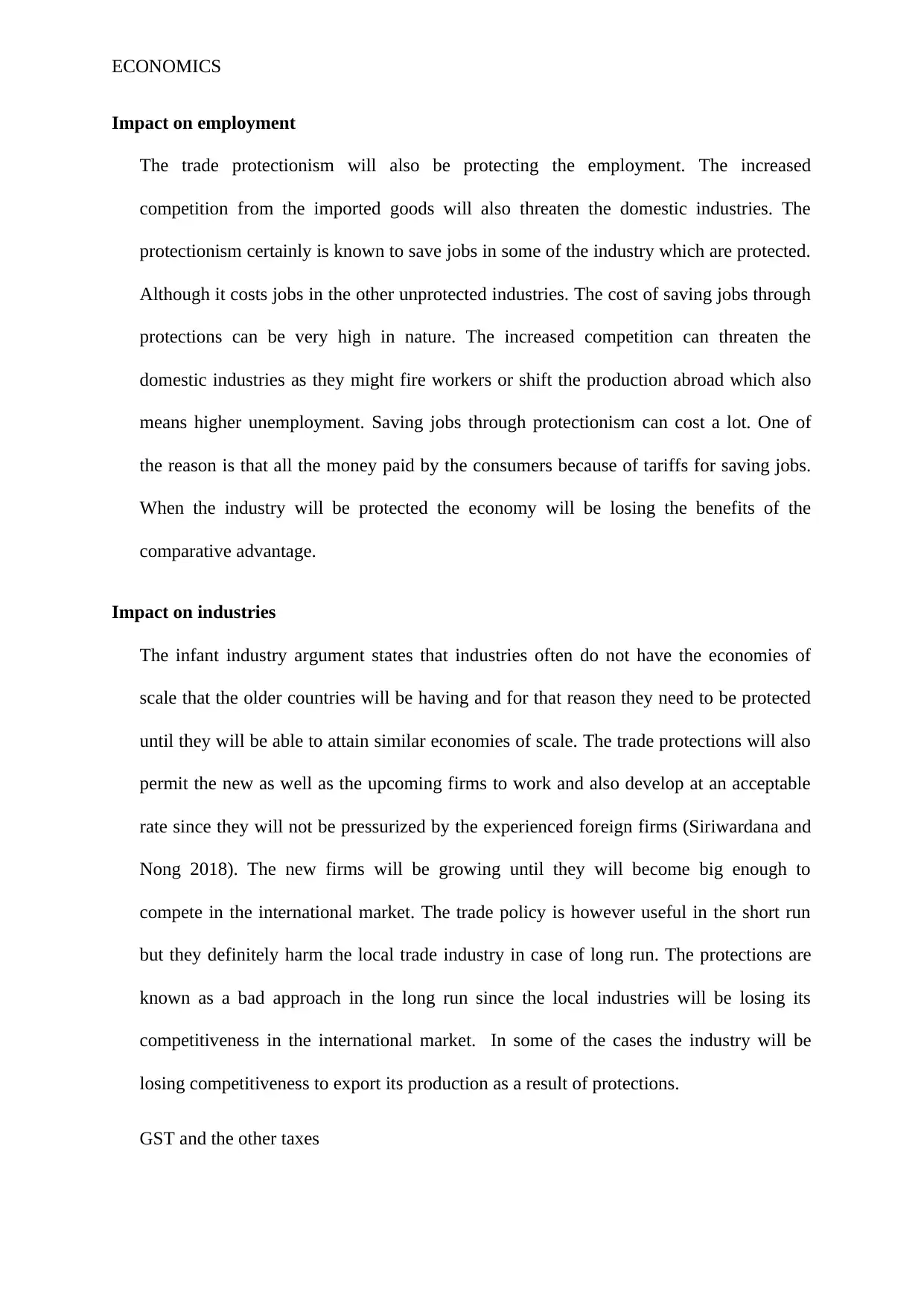
ECONOMICS
Impact on employment
The trade protectionism will also be protecting the employment. The increased
competition from the imported goods will also threaten the domestic industries. The
protectionism certainly is known to save jobs in some of the industry which are protected.
Although it costs jobs in the other unprotected industries. The cost of saving jobs through
protections can be very high in nature. The increased competition can threaten the
domestic industries as they might fire workers or shift the production abroad which also
means higher unemployment. Saving jobs through protectionism can cost a lot. One of
the reason is that all the money paid by the consumers because of tariffs for saving jobs.
When the industry will be protected the economy will be losing the benefits of the
comparative advantage.
Impact on industries
The infant industry argument states that industries often do not have the economies of
scale that the older countries will be having and for that reason they need to be protected
until they will be able to attain similar economies of scale. The trade protections will also
permit the new as well as the upcoming firms to work and also develop at an acceptable
rate since they will not be pressurized by the experienced foreign firms (Siriwardana and
Nong 2018). The new firms will be growing until they will become big enough to
compete in the international market. The trade policy is however useful in the short run
but they definitely harm the local trade industry in case of long run. The protections are
known as a bad approach in the long run since the local industries will be losing its
competitiveness in the international market. In some of the cases the industry will be
losing competitiveness to export its production as a result of protections.
GST and the other taxes
Impact on employment
The trade protectionism will also be protecting the employment. The increased
competition from the imported goods will also threaten the domestic industries. The
protectionism certainly is known to save jobs in some of the industry which are protected.
Although it costs jobs in the other unprotected industries. The cost of saving jobs through
protections can be very high in nature. The increased competition can threaten the
domestic industries as they might fire workers or shift the production abroad which also
means higher unemployment. Saving jobs through protectionism can cost a lot. One of
the reason is that all the money paid by the consumers because of tariffs for saving jobs.
When the industry will be protected the economy will be losing the benefits of the
comparative advantage.
Impact on industries
The infant industry argument states that industries often do not have the economies of
scale that the older countries will be having and for that reason they need to be protected
until they will be able to attain similar economies of scale. The trade protections will also
permit the new as well as the upcoming firms to work and also develop at an acceptable
rate since they will not be pressurized by the experienced foreign firms (Siriwardana and
Nong 2018). The new firms will be growing until they will become big enough to
compete in the international market. The trade policy is however useful in the short run
but they definitely harm the local trade industry in case of long run. The protections are
known as a bad approach in the long run since the local industries will be losing its
competitiveness in the international market. In some of the cases the industry will be
losing competitiveness to export its production as a result of protections.
GST and the other taxes
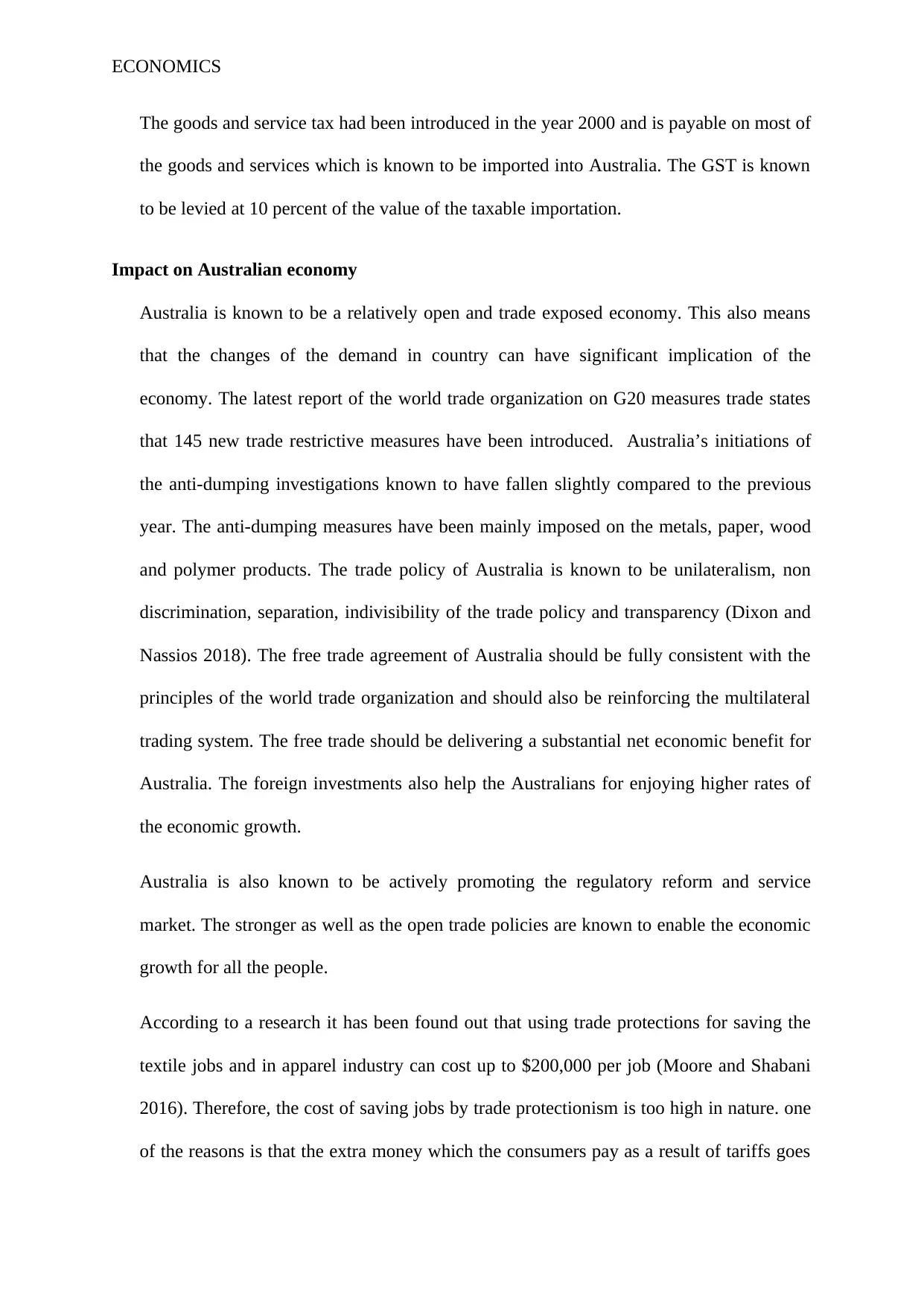
ECONOMICS
The goods and service tax had been introduced in the year 2000 and is payable on most of
the goods and services which is known to be imported into Australia. The GST is known
to be levied at 10 percent of the value of the taxable importation.
Impact on Australian economy
Australia is known to be a relatively open and trade exposed economy. This also means
that the changes of the demand in country can have significant implication of the
economy. The latest report of the world trade organization on G20 measures trade states
that 145 new trade restrictive measures have been introduced. Australia’s initiations of
the anti-dumping investigations known to have fallen slightly compared to the previous
year. The anti-dumping measures have been mainly imposed on the metals, paper, wood
and polymer products. The trade policy of Australia is known to be unilateralism, non
discrimination, separation, indivisibility of the trade policy and transparency (Dixon and
Nassios 2018). The free trade agreement of Australia should be fully consistent with the
principles of the world trade organization and should also be reinforcing the multilateral
trading system. The free trade should be delivering a substantial net economic benefit for
Australia. The foreign investments also help the Australians for enjoying higher rates of
the economic growth.
Australia is also known to be actively promoting the regulatory reform and service
market. The stronger as well as the open trade policies are known to enable the economic
growth for all the people.
According to a research it has been found out that using trade protections for saving the
textile jobs and in apparel industry can cost up to $200,000 per job (Moore and Shabani
2016). Therefore, the cost of saving jobs by trade protectionism is too high in nature. one
of the reasons is that the extra money which the consumers pay as a result of tariffs goes
The goods and service tax had been introduced in the year 2000 and is payable on most of
the goods and services which is known to be imported into Australia. The GST is known
to be levied at 10 percent of the value of the taxable importation.
Impact on Australian economy
Australia is known to be a relatively open and trade exposed economy. This also means
that the changes of the demand in country can have significant implication of the
economy. The latest report of the world trade organization on G20 measures trade states
that 145 new trade restrictive measures have been introduced. Australia’s initiations of
the anti-dumping investigations known to have fallen slightly compared to the previous
year. The anti-dumping measures have been mainly imposed on the metals, paper, wood
and polymer products. The trade policy of Australia is known to be unilateralism, non
discrimination, separation, indivisibility of the trade policy and transparency (Dixon and
Nassios 2018). The free trade agreement of Australia should be fully consistent with the
principles of the world trade organization and should also be reinforcing the multilateral
trading system. The free trade should be delivering a substantial net economic benefit for
Australia. The foreign investments also help the Australians for enjoying higher rates of
the economic growth.
Australia is also known to be actively promoting the regulatory reform and service
market. The stronger as well as the open trade policies are known to enable the economic
growth for all the people.
According to a research it has been found out that using trade protections for saving the
textile jobs and in apparel industry can cost up to $200,000 per job (Moore and Shabani
2016). Therefore, the cost of saving jobs by trade protectionism is too high in nature. one
of the reasons is that the extra money which the consumers pay as a result of tariffs goes
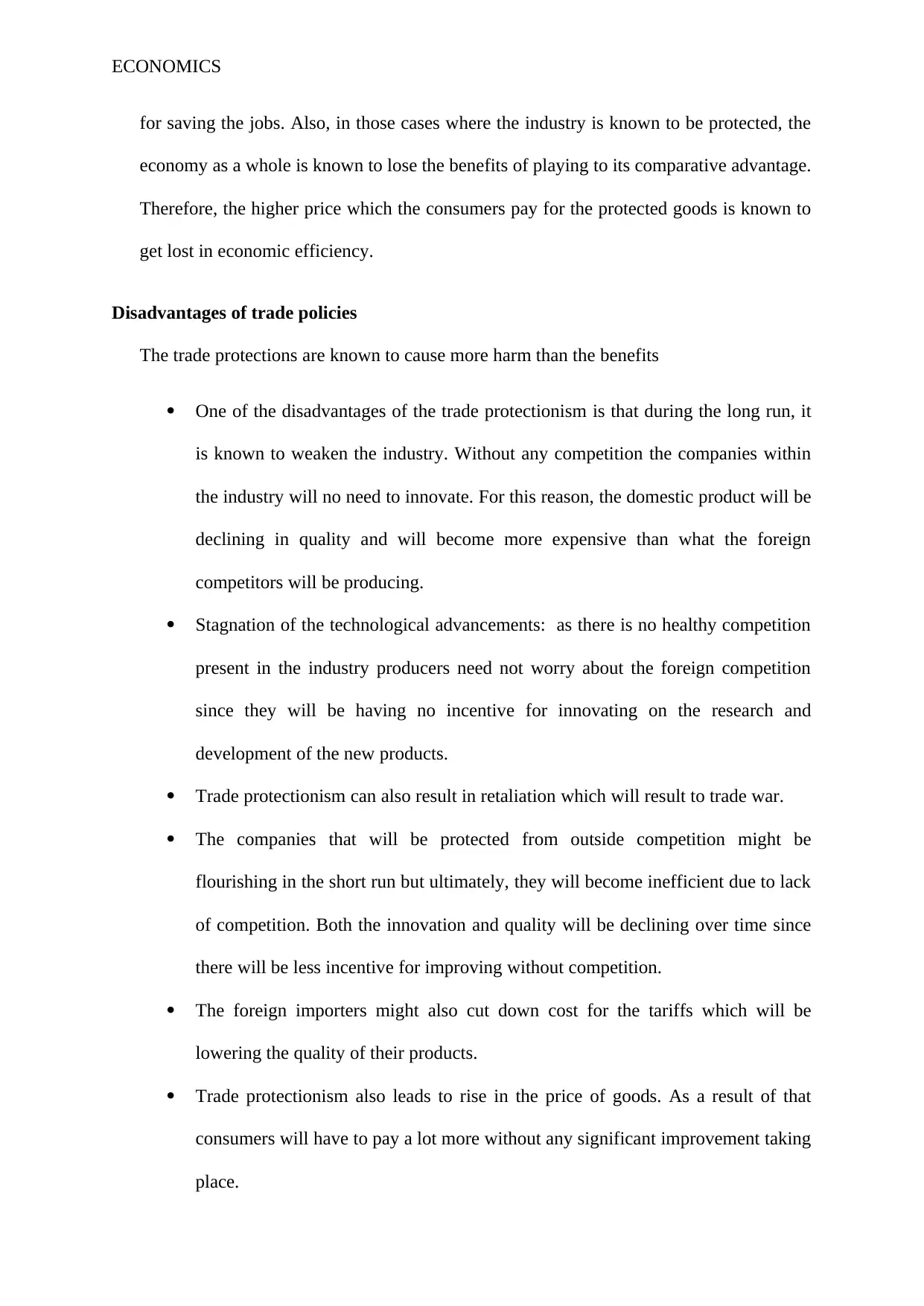
ECONOMICS
for saving the jobs. Also, in those cases where the industry is known to be protected, the
economy as a whole is known to lose the benefits of playing to its comparative advantage.
Therefore, the higher price which the consumers pay for the protected goods is known to
get lost in economic efficiency.
Disadvantages of trade policies
The trade protections are known to cause more harm than the benefits
One of the disadvantages of the trade protectionism is that during the long run, it
is known to weaken the industry. Without any competition the companies within
the industry will no need to innovate. For this reason, the domestic product will be
declining in quality and will become more expensive than what the foreign
competitors will be producing.
Stagnation of the technological advancements: as there is no healthy competition
present in the industry producers need not worry about the foreign competition
since they will be having no incentive for innovating on the research and
development of the new products.
Trade protectionism can also result in retaliation which will result to trade war.
The companies that will be protected from outside competition might be
flourishing in the short run but ultimately, they will become inefficient due to lack
of competition. Both the innovation and quality will be declining over time since
there will be less incentive for improving without competition.
The foreign importers might also cut down cost for the tariffs which will be
lowering the quality of their products.
Trade protectionism also leads to rise in the price of goods. As a result of that
consumers will have to pay a lot more without any significant improvement taking
place.
for saving the jobs. Also, in those cases where the industry is known to be protected, the
economy as a whole is known to lose the benefits of playing to its comparative advantage.
Therefore, the higher price which the consumers pay for the protected goods is known to
get lost in economic efficiency.
Disadvantages of trade policies
The trade protections are known to cause more harm than the benefits
One of the disadvantages of the trade protectionism is that during the long run, it
is known to weaken the industry. Without any competition the companies within
the industry will no need to innovate. For this reason, the domestic product will be
declining in quality and will become more expensive than what the foreign
competitors will be producing.
Stagnation of the technological advancements: as there is no healthy competition
present in the industry producers need not worry about the foreign competition
since they will be having no incentive for innovating on the research and
development of the new products.
Trade protectionism can also result in retaliation which will result to trade war.
The companies that will be protected from outside competition might be
flourishing in the short run but ultimately, they will become inefficient due to lack
of competition. Both the innovation and quality will be declining over time since
there will be less incentive for improving without competition.
The foreign importers might also cut down cost for the tariffs which will be
lowering the quality of their products.
Trade protectionism also leads to rise in the price of goods. As a result of that
consumers will have to pay a lot more without any significant improvement taking
place.
Secure Best Marks with AI Grader
Need help grading? Try our AI Grader for instant feedback on your assignments.
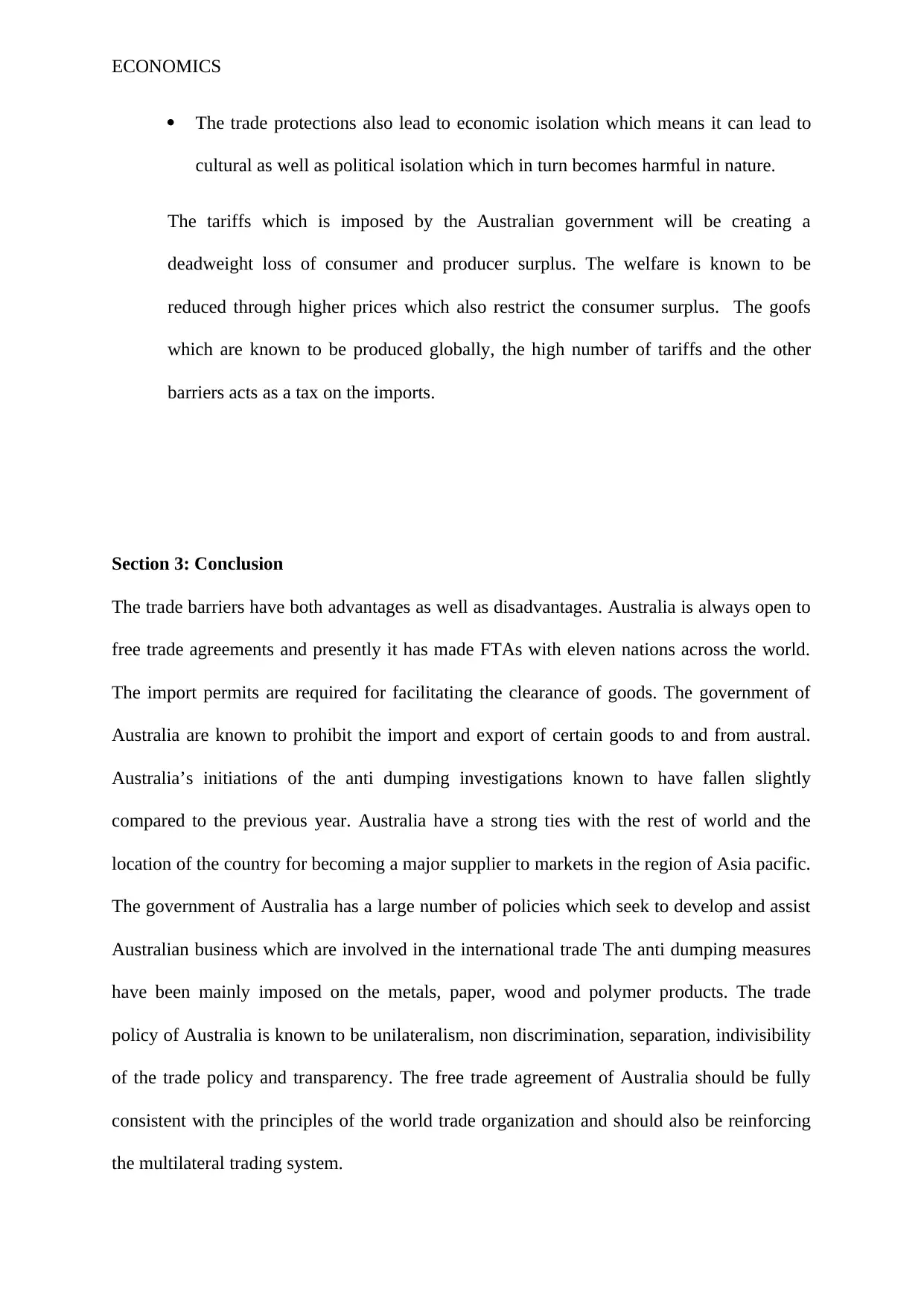
ECONOMICS
The trade protections also lead to economic isolation which means it can lead to
cultural as well as political isolation which in turn becomes harmful in nature.
The tariffs which is imposed by the Australian government will be creating a
deadweight loss of consumer and producer surplus. The welfare is known to be
reduced through higher prices which also restrict the consumer surplus. The goofs
which are known to be produced globally, the high number of tariffs and the other
barriers acts as a tax on the imports.
Section 3: Conclusion
The trade barriers have both advantages as well as disadvantages. Australia is always open to
free trade agreements and presently it has made FTAs with eleven nations across the world.
The import permits are required for facilitating the clearance of goods. The government of
Australia are known to prohibit the import and export of certain goods to and from austral.
Australia’s initiations of the anti dumping investigations known to have fallen slightly
compared to the previous year. Australia have a strong ties with the rest of world and the
location of the country for becoming a major supplier to markets in the region of Asia pacific.
The government of Australia has a large number of policies which seek to develop and assist
Australian business which are involved in the international trade The anti dumping measures
have been mainly imposed on the metals, paper, wood and polymer products. The trade
policy of Australia is known to be unilateralism, non discrimination, separation, indivisibility
of the trade policy and transparency. The free trade agreement of Australia should be fully
consistent with the principles of the world trade organization and should also be reinforcing
the multilateral trading system.
The trade protections also lead to economic isolation which means it can lead to
cultural as well as political isolation which in turn becomes harmful in nature.
The tariffs which is imposed by the Australian government will be creating a
deadweight loss of consumer and producer surplus. The welfare is known to be
reduced through higher prices which also restrict the consumer surplus. The goofs
which are known to be produced globally, the high number of tariffs and the other
barriers acts as a tax on the imports.
Section 3: Conclusion
The trade barriers have both advantages as well as disadvantages. Australia is always open to
free trade agreements and presently it has made FTAs with eleven nations across the world.
The import permits are required for facilitating the clearance of goods. The government of
Australia are known to prohibit the import and export of certain goods to and from austral.
Australia’s initiations of the anti dumping investigations known to have fallen slightly
compared to the previous year. Australia have a strong ties with the rest of world and the
location of the country for becoming a major supplier to markets in the region of Asia pacific.
The government of Australia has a large number of policies which seek to develop and assist
Australian business which are involved in the international trade The anti dumping measures
have been mainly imposed on the metals, paper, wood and polymer products. The trade
policy of Australia is known to be unilateralism, non discrimination, separation, indivisibility
of the trade policy and transparency. The free trade agreement of Australia should be fully
consistent with the principles of the world trade organization and should also be reinforcing
the multilateral trading system.

ECONOMICS
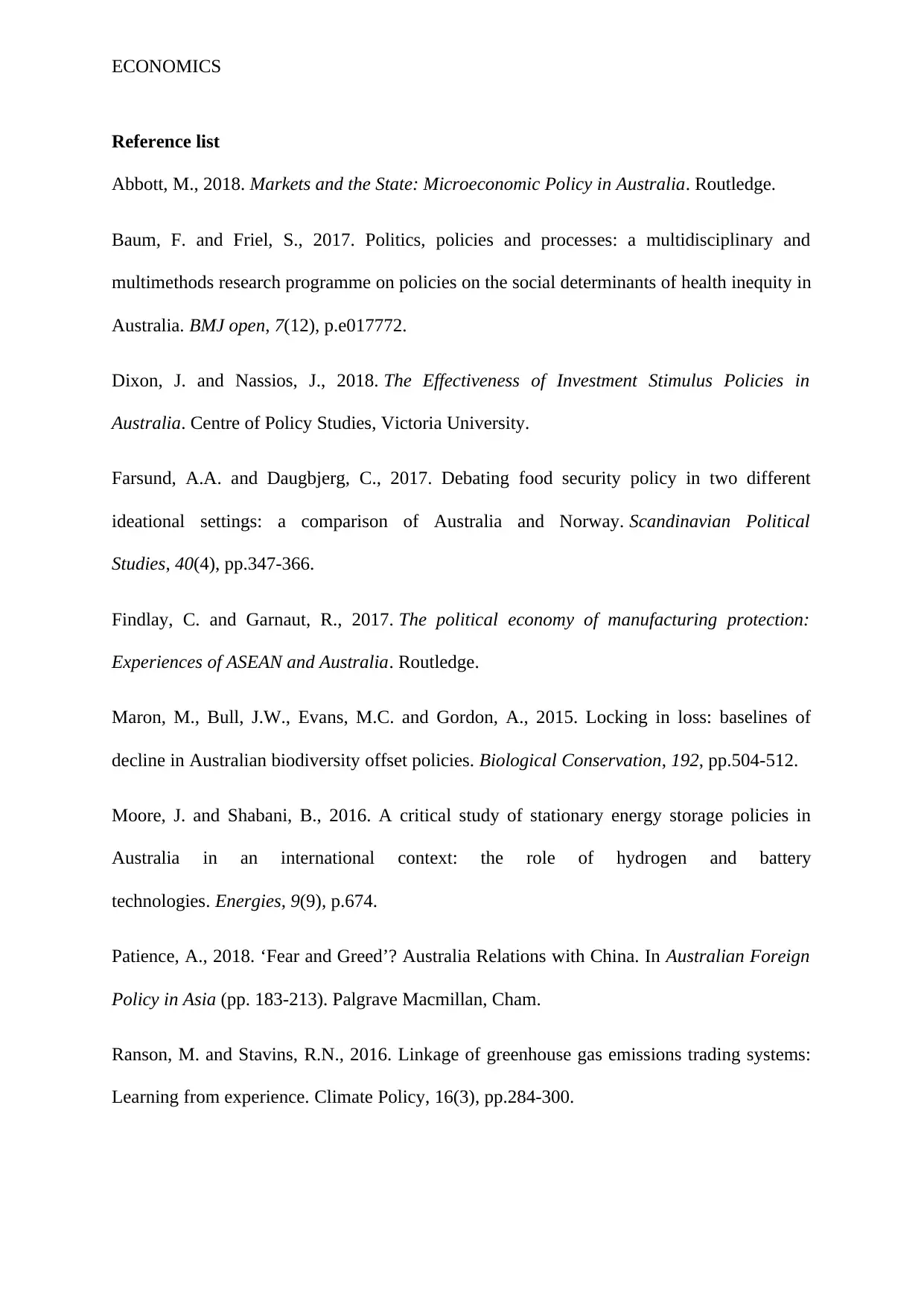
ECONOMICS
Reference list
Abbott, M., 2018. Markets and the State: Microeconomic Policy in Australia. Routledge.
Baum, F. and Friel, S., 2017. Politics, policies and processes: a multidisciplinary and
multimethods research programme on policies on the social determinants of health inequity in
Australia. BMJ open, 7(12), p.e017772.
Dixon, J. and Nassios, J., 2018. The Effectiveness of Investment Stimulus Policies in
Australia. Centre of Policy Studies, Victoria University.
Farsund, A.A. and Daugbjerg, C., 2017. Debating food security policy in two different
ideational settings: a comparison of Australia and Norway. Scandinavian Political
Studies, 40(4), pp.347-366.
Findlay, C. and Garnaut, R., 2017. The political economy of manufacturing protection:
Experiences of ASEAN and Australia. Routledge.
Maron, M., Bull, J.W., Evans, M.C. and Gordon, A., 2015. Locking in loss: baselines of
decline in Australian biodiversity offset policies. Biological Conservation, 192, pp.504-512.
Moore, J. and Shabani, B., 2016. A critical study of stationary energy storage policies in
Australia in an international context: the role of hydrogen and battery
technologies. Energies, 9(9), p.674.
Patience, A., 2018. ‘Fear and Greed’? Australia Relations with China. In Australian Foreign
Policy in Asia (pp. 183-213). Palgrave Macmillan, Cham.
Ranson, M. and Stavins, R.N., 2016. Linkage of greenhouse gas emissions trading systems:
Learning from experience. Climate Policy, 16(3), pp.284-300.
Reference list
Abbott, M., 2018. Markets and the State: Microeconomic Policy in Australia. Routledge.
Baum, F. and Friel, S., 2017. Politics, policies and processes: a multidisciplinary and
multimethods research programme on policies on the social determinants of health inequity in
Australia. BMJ open, 7(12), p.e017772.
Dixon, J. and Nassios, J., 2018. The Effectiveness of Investment Stimulus Policies in
Australia. Centre of Policy Studies, Victoria University.
Farsund, A.A. and Daugbjerg, C., 2017. Debating food security policy in two different
ideational settings: a comparison of Australia and Norway. Scandinavian Political
Studies, 40(4), pp.347-366.
Findlay, C. and Garnaut, R., 2017. The political economy of manufacturing protection:
Experiences of ASEAN and Australia. Routledge.
Maron, M., Bull, J.W., Evans, M.C. and Gordon, A., 2015. Locking in loss: baselines of
decline in Australian biodiversity offset policies. Biological Conservation, 192, pp.504-512.
Moore, J. and Shabani, B., 2016. A critical study of stationary energy storage policies in
Australia in an international context: the role of hydrogen and battery
technologies. Energies, 9(9), p.674.
Patience, A., 2018. ‘Fear and Greed’? Australia Relations with China. In Australian Foreign
Policy in Asia (pp. 183-213). Palgrave Macmillan, Cham.
Ranson, M. and Stavins, R.N., 2016. Linkage of greenhouse gas emissions trading systems:
Learning from experience. Climate Policy, 16(3), pp.284-300.
Paraphrase This Document
Need a fresh take? Get an instant paraphrase of this document with our AI Paraphraser
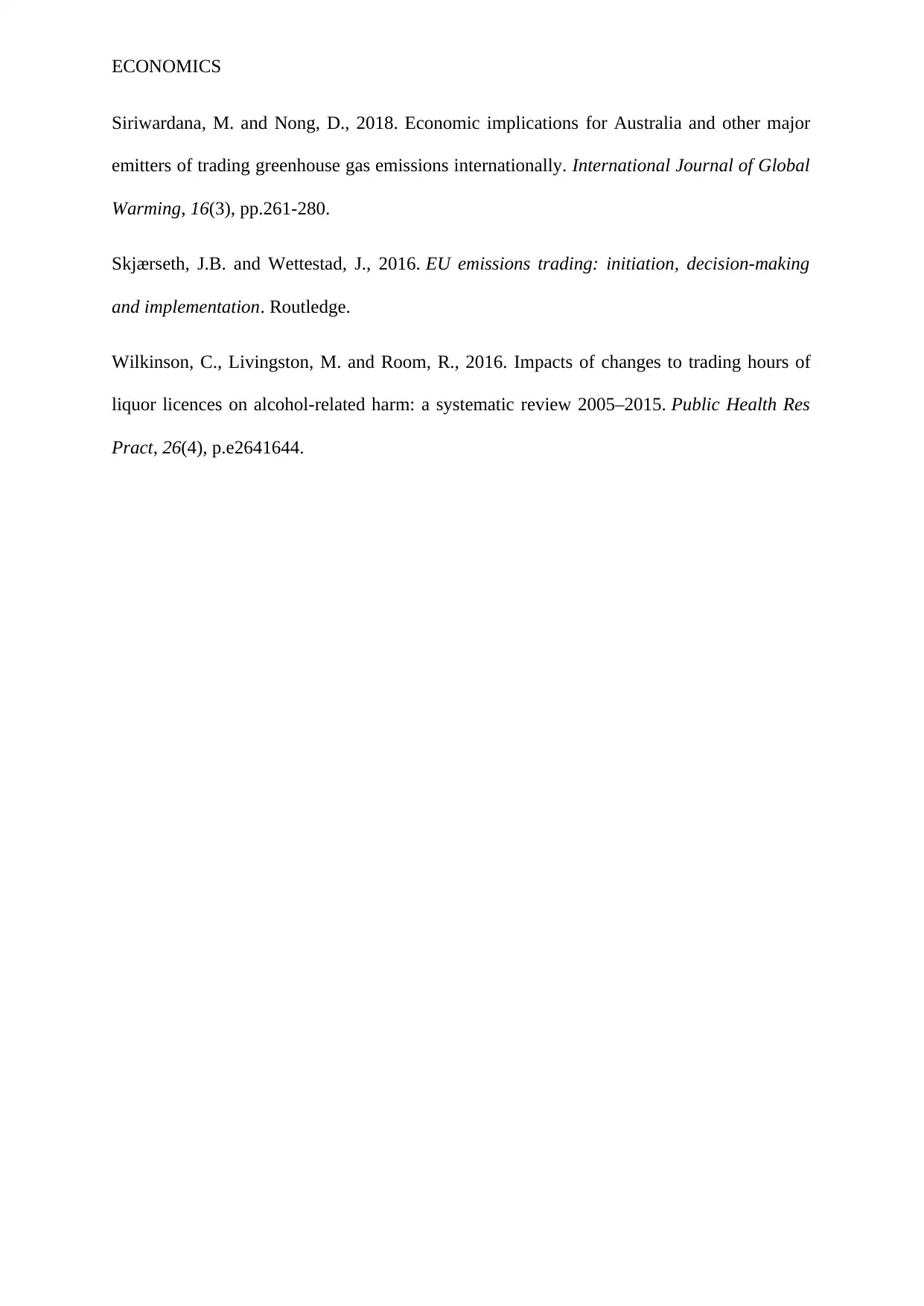
ECONOMICS
Siriwardana, M. and Nong, D., 2018. Economic implications for Australia and other major
emitters of trading greenhouse gas emissions internationally. International Journal of Global
Warming, 16(3), pp.261-280.
Skjærseth, J.B. and Wettestad, J., 2016. EU emissions trading: initiation, decision-making
and implementation. Routledge.
Wilkinson, C., Livingston, M. and Room, R., 2016. Impacts of changes to trading hours of
liquor licences on alcohol-related harm: a systematic review 2005–2015. Public Health Res
Pract, 26(4), p.e2641644.
Siriwardana, M. and Nong, D., 2018. Economic implications for Australia and other major
emitters of trading greenhouse gas emissions internationally. International Journal of Global
Warming, 16(3), pp.261-280.
Skjærseth, J.B. and Wettestad, J., 2016. EU emissions trading: initiation, decision-making
and implementation. Routledge.
Wilkinson, C., Livingston, M. and Room, R., 2016. Impacts of changes to trading hours of
liquor licences on alcohol-related harm: a systematic review 2005–2015. Public Health Res
Pract, 26(4), p.e2641644.
1 out of 14
Related Documents
Your All-in-One AI-Powered Toolkit for Academic Success.
+13062052269
info@desklib.com
Available 24*7 on WhatsApp / Email
![[object Object]](/_next/static/media/star-bottom.7253800d.svg)
Unlock your academic potential
© 2024 | Zucol Services PVT LTD | All rights reserved.





